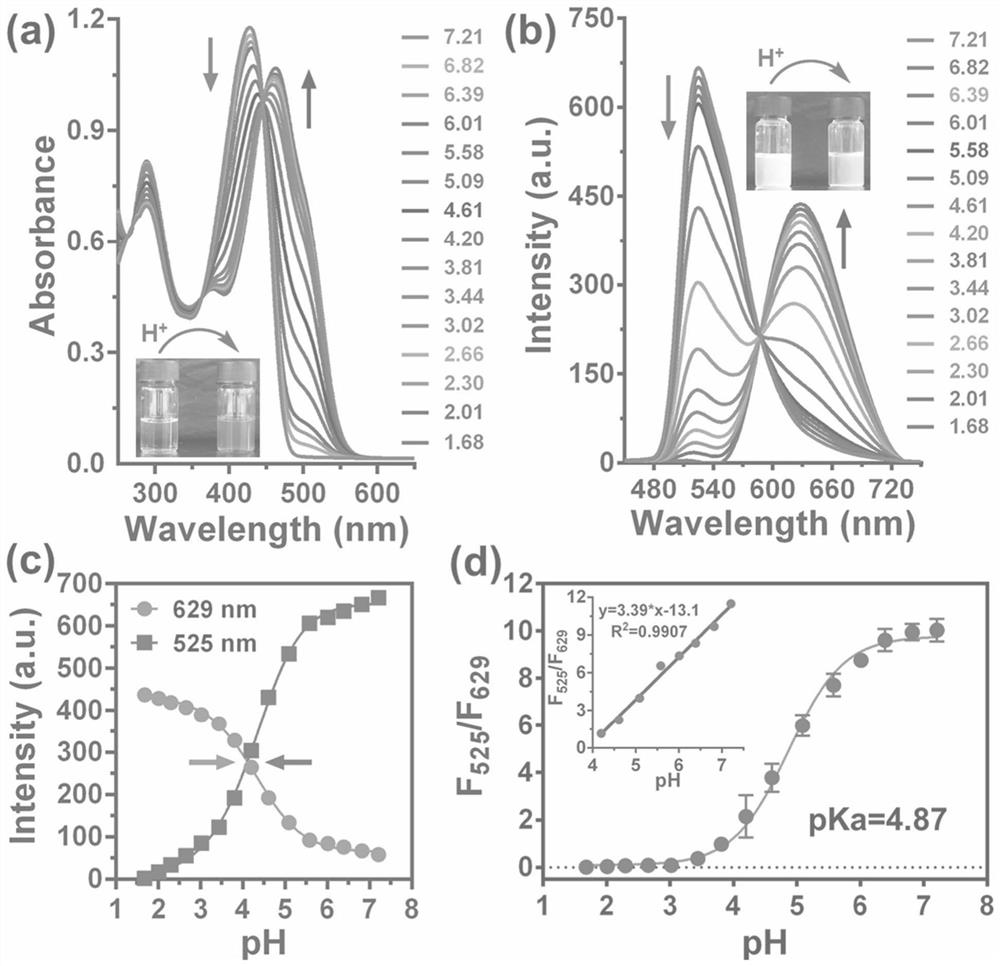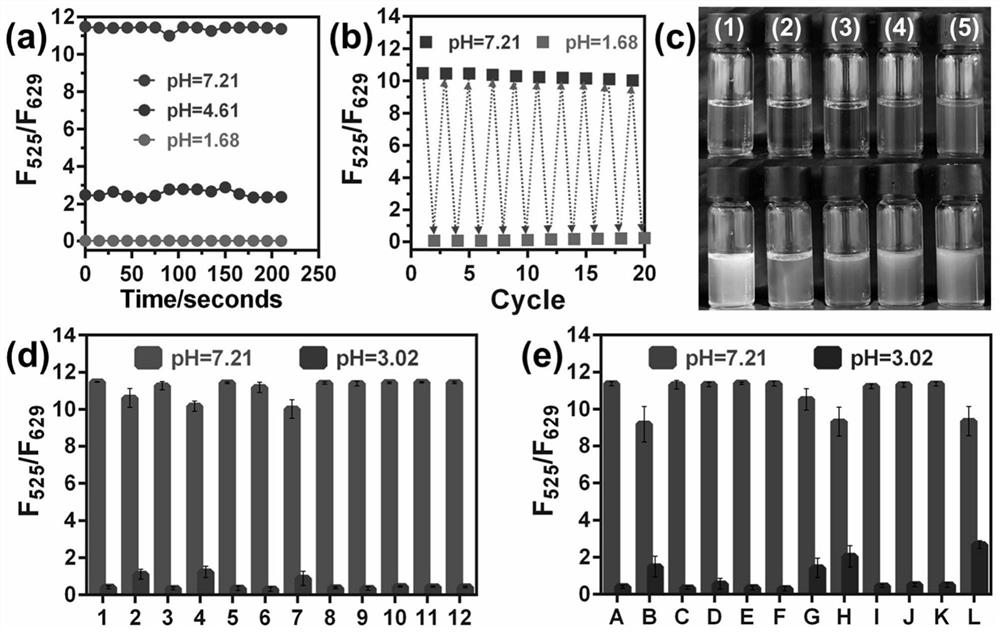Preparation method of ph ratio fluorescent probe sp-dcch and its application in biological imaging
A fluorescent probe, ratiometric technology, applied in the direction of fluorescence/phosphorescence, chemical instruments and methods, luminescent materials, etc., can solve the problems of photobleaching, short action time, low load rate, etc., and achieve high reversibility and long duration , the effect of strong stability
- Summary
- Abstract
- Description
- Claims
- Application Information
AI Technical Summary
Problems solved by technology
Method used
Image
Examples
Embodiment 1
[0027] Example 1 Synthesis of Small Molecular Probes
[0028] Prepare 6-tert-butyl-1',3',3'-trimethylspiro[2,2'-indoline]-8-carbaldehyde (250 mg, 1.0 mmol) in 20 mL of absolute ethanol, And fully stirred at 25 ° C for 30 minutes. (210 mg, 1.0 mmol) of 7-(diethylamino)-2-oxo-2H-methylene-3-carbohydrazide was added to the above reaction system. The reaction was stirred at 25°C for 20 hours, the reaction solution was filtered, and the solid was washed several times with ice-cold ethanol and ether to obtain 215 mg of the target product (marked as SP-DCCH). The solid powder is orange. Yield: 54%.
[0029] 1 H NMR (600MHz, DMSO-d 6)δin ppm: 11.82(br s, 2H), 8.54(s, 1H), 8.78(s, 1H), 8.43(s, 1H), 8.35(s, 1H), 7.73(s, 1H), 7.81(br s, 2H), 7.73-7.52(m, 5H), 3.42(q, J=6.8Hz, 4H), 2.37(s, 3H), 1.17(t, J=6.8Hz, 6H), 1.14(s, 9H ), 1.12(s, 3H), 1.02(s, 3H);
[0030] HRMS(ESI)m / z[M+1] + : Calcd for C 38 h 43 N 4 o 4 , 619.3279, found, 619.3275.
[0031] The roadmap for the synt...
Embodiment 2
[0032] Example 2 UV and fluorescence spectra of small molecule probes in response to pH value
[0033] Prepare 1 mL of small molecule probe (10 μM) in EtOH-PBS (v / v, 1:100) solution. Among them, different pH value experimental groups (7.21 to 1.68) were selected as the buffer solution.
[0034] To explore the optical response of SP-DCCH to pH, absorption and fluorescence spectroscopic titrations were performed under different pH gradients. Such as figure 2 As shown in a, SP-DCCH has a strong absorption band from 360 to 480 nm in neutral medium (pH 7.21), and the maximum absorption wavelength is 428 nm. When the pH gradually decreased, the band at 428nm gradually decreased and disappeared. At the same time, new bands were generated in the range of 410nm and 500nm (λmax=463nm), and the color of the solution changed from green to yellow. This result suggests that SP-DCCH can be used as a basis for monitoring pH through spectral absorption intensity, or roughly as a naked eye...
Embodiment 3
[0038] Example 3 Verifying the Time Kinetic Study of Small Molecule Probes in Response to pH
[0039] See the experimental results image 3 (a) It can be seen that the fluorescence intensity ratio (F 525 / F 629 ) detection remains stable. Under the acidic pH condition of the SP-DCCH probe, the fluorescence increases and reaches the value within 150s, and stabilizes after 150s.
[0040] image 3 (b) under the condition of pH=1.68 and pH=7.21, the F of SP-DCCH 525 / F 629 A total of 20 tests were performed for the study of changes over time. It can be seen that through repeated experiments, the probe has a high degree of reversibility and strong stability in buffer solutions with pHs of 1.68 and 7.21.
[0041] image 3 (d and e) Effects of different cations and anions on the response of small molecule probes to different pH values, attached image 3 The cations 1-12 in d are 1:SP-DCCH, 2:Zn respectively 2+ , 3: Ni 2+ , 4: Cd 2+ , 5: Al 3+ , 6: Fe 3+ , 7: pb 2+ , 8:...
PUM
 Login to View More
Login to View More Abstract
Description
Claims
Application Information
 Login to View More
Login to View More - R&D
- Intellectual Property
- Life Sciences
- Materials
- Tech Scout
- Unparalleled Data Quality
- Higher Quality Content
- 60% Fewer Hallucinations
Browse by: Latest US Patents, China's latest patents, Technical Efficacy Thesaurus, Application Domain, Technology Topic, Popular Technical Reports.
© 2025 PatSnap. All rights reserved.Legal|Privacy policy|Modern Slavery Act Transparency Statement|Sitemap|About US| Contact US: help@patsnap.com



